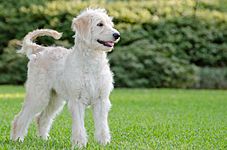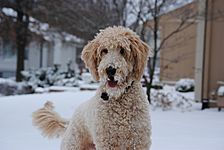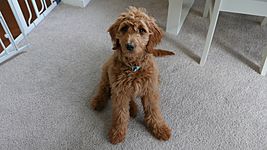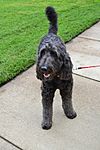Goldendoodle facts for kids
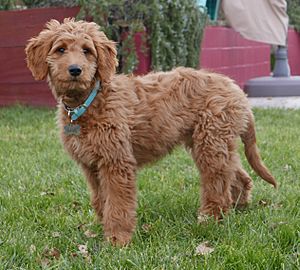 |
|||||||||||||||||||||||||||||||||||||
| Common nicknames | Doodle | ||||||||||||||||||||||||||||||||||||
|---|---|---|---|---|---|---|---|---|---|---|---|---|---|---|---|---|---|---|---|---|---|---|---|---|---|---|---|---|---|---|---|---|---|---|---|---|---|
| Origin | Australia & United States |
||||||||||||||||||||||||||||||||||||
| Foundation stock | Golden Retriever & Poodle | ||||||||||||||||||||||||||||||||||||
| Breed status | Not recognized as a standardized breed by any major kennel club. | ||||||||||||||||||||||||||||||||||||
|
|||||||||||||||||||||||||||||||||||||
| Domestic dog (Canis lupus familiaris) | |||||||||||||||||||||||||||||||||||||
The Goldendoodle is a popular type of dog created by mixing two different breeds: a Golden Retriever and a Poodle. These dogs are sometimes called "designer dogs" because they are carefully bred to combine traits from both parent breeds. Goldendoodles became widely known in the 1990s.
They come in three main sizes, which depend on the size of the Poodle parent. Goldendoodles often have the friendly and people-loving nature of a Golden Retriever. They also get the smart personality and a coat that is often better for people with allergies from the Poodle side.
Contents
History of Goldendoodles
In the 1990s, dog breeders in Australia and the United States began mixing Golden Retrievers and Poodles. They started calling these new dogs "Goldendoodles." The name "doodle" is also a common nickname for them. The "golden" part comes from the Golden Retriever, and "doodle" comes from the Labradoodle, another popular mixed breed.
Mixing Golden Retrievers and Poodles actually happened even before the 1990s. For example, Monica Dickens, who was the great-granddaughter of the famous writer Charles Dickens, bred these two types of dogs together in 1969. Sometimes, mixing two different breeds can result in a healthier animal than either of the purebred parents.
The first goal for Goldendoodle breeders was to create a dog similar to the popular Labradoodle. At first, Goldendoodles were only bred using standard-sized Poodles. But later, breeders started using smaller Poodles to make miniature Goldendoodles. Because Goldendoodles are a mixed breed, they are not officially recognized by major dog clubs like the AKC (American Kennel Club) or British Kennel Clubs.
Goldendoodles have also been bred beyond the first generation (a Golden Retriever mixed with a Poodle). Now, you can find "multigenerational" Goldendoodles, which means they come from two Goldendoodle parents.
What Goldendoodles Look Like
Appearance and Size
The way a Goldendoodle looks can change a lot. It depends on their family tree and what kind of Poodle their parents were. While many Goldendoodles share similar features, each one can have its own special look and personality.
Generally, Goldendoodles have round heads and wide snouts. They have long, feathery tails and floppy ears. Their eyes are usually oval-shaped. Because of their Golden Retriever background, their bodies are often long and strong. They tend to have a deep chest and stand wide.
Goldendoodles can be bred from Standard, Miniature, or Toy-sized Poodles. This means they come in different sizes:
- Standard Goldendoodles are usually about 20 to 25 inches tall. They weigh between 51 and 80 pounds.
- Medium Goldendoodles are typically 17 to 20 inches tall. They weigh about 36 to 50 pounds.
- Miniature Goldendoodles are usually up to 20 inches tall. They weigh between 15 and 35 pounds.
Coat Types and Colors
Goldendoodles have long hair, and their coats can look very different. There are three main types of coats:
- Straight coat: This coat is similar to a Golden Retriever's fur.
- Wavy coat: This is a mix of the Poodle's curly coat and the Golden Retriever's straight coat. It has loose, shaggy waves and is the most common type.
- Curly coat: This coat looks more like a Poodle's fur. It is thick and very curly.
Goldendoodle coats come in many colors. The most common colors are cream, red, black, gold, apricot, brown, or a mix of colors (called parti-colored).
Some people say Goldendoodles are "hypoallergenic" or "non-shedding." However, experts agree that no dog breed is truly 100% hypoallergenic. Even dogs that shed very little can still cause allergies. It was once thought that the more Poodle a Goldendoodle had in its family, the less it would shed. Also, curlier coated Goldendoodles were thought to shed less and produce less dander (tiny flakes of skin that can cause allergies).
Goldendoodle Behavior
In general, Goldendoodles often get their friendly, loving, and excited nature from the Golden Retriever. From the Poodle, they get their intelligence, social skills, and how easy they are to train. Goldendoodles are usually very energetic, loyal, and playful. They are often good with children and make great family pets.
However, because they are so friendly and loyal, they can sometimes get separation anxiety. This means they get very stressed when left alone, especially when they are puppies. Goldendoodles also often have strong retrieving instincts. This comes from their parent breeds, which were originally used for hunting. This means they might like to carry things in their mouths and enjoy playing fetch.
A study in 2019 looked at Goldendoodle behavior compared to their parent breeds. It found that Goldendoodles were less likely to fight with other dogs than Miniature Poodles. However, they showed more aggression and fear towards other dogs and strangers than purebred Golden Retrievers, Miniature Poodles, or Standard Poodles.
Goldendoodle Health
Goldendoodles might avoid some health problems that their parent breeds can have. But they could also be more likely to have health issues if their parents were not healthy to begin with. Goldendoodles can sometimes be prone to a condition called megaesophagus, which affects their throat.
Popularity and Uses
Goldendoodles are mostly bred to be companion dogs, meaning they are pets that live with families. But they have also been trained for many important jobs. They work as therapy dogs, helping people feel better. They can be guide dogs for people who are blind. Some are even trained to detect nuts in food for people with severe nut allergies. They also serve as other types of assistance dogs.
In some parts of the United States, Goldendoodles have become one of the most popular dog types. In Australia, they were named one of the top twenty most popular dog varieties in 2020. During the COVID-19 pandemic, more people wanted pets. Because of this, the price for a Goldendoodle puppy in Australia went up a lot. Before the pandemic, a puppy might cost around $3,500 AUD. By September 2020, some puppies were selling for as much as $15,000 AUD.
In 2012, the American musician Usher paid US$12,000 for a Goldendoodle puppy at a charity auction. Even with their growing popularity, Goldendoodles are still not officially recognized by major dog organizations like the American Kennel Club (AKC) or British Kennel Clubs. This is because they are a mixed breed, not a purebred dog.
See also
 In Spanish: Goldendoodle para niños
In Spanish: Goldendoodle para niños
- List of dog crossbreeds
- Doodle (disambiguation)



